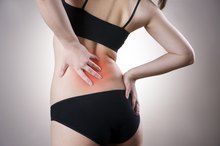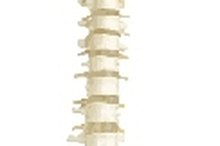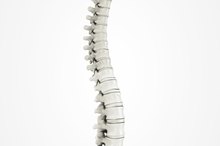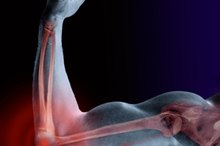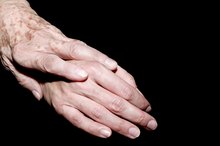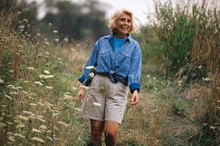Degenerative Changes of the Thoracic Spine
The thoracic spine is the mid-portion of your back and extends from the base of the neck to the bottom of the rib cage. It is made up of 12 thoracic vertebrae, which are separated by soft spongy discs that aid in shock absorption. The thoracic spine has less movement and experiences less stress than any other part of the spine. Because of this fact, it generally has less degeneration than the neck and low back, according to MDguidelines.com. Degenerative changes that do occur here can lead to symptoms of pain, numbness and tingling, and restricted motion. Conservative treatment is often effective at reducing pain and improving mobility.
Degenerative Disc Disease
Degenerative disc disease (DDD) is a process that breaks down the inter-vertebral discs. Each of these discs is comprised of a tough fibrous outer ring called the annulus fibrosis, which contains the soft jellylike center portion called the nucleus pulposus. Through injury, poor posture or age-related degeneration, the annulus dries up and cracks, allowing the nucleus to bulge outside its normal confines. This bulging can put pressure on nearby spinal nerves and cause symptoms of pain, numbness and tingling, and muscle weakness. Symptomatic DDD generally responds well to conservative treatment. Over-the-counter nonsteroidal anti-inflammatory drugs (NSAIDS), such as ibuprofen, aspirin and naproxen, are helpful because they have both pain relieving and anti-inflammatory properties, according to the Mayo Clinic.
- Degenerative disc disease (DDD) is a process that breaks down the inter-vertebral discs.
- Through injury, poor posture or age-related degeneration, the annulus dries up and cracks, allowing the nucleus to bulge outside its normal confines.
Hyperkyphosis
Lower Back Arthritis Symptoms
Learn More
The term, kyphosis describes a normal posterior curved in the spine. The thoracic and sacral regions of the spine normally have a kyphosis to them, while the lumbar and cervical regions have the opposite curves, a lordosis. Hyperkyphosis is an excessive degree to this curve that causes compaction and excessive wear and tear on discs, vertebra and soft tissue. Hyperkyphosis is often seen in the elderly, and can result from several different conditions such as osteoporosis, Scheuermann’s kyphosis and postural roundback. Conservative treatment is aimed at strengthening thoracic extensor muscles and restoring motion to fixated joints, according to the American Academy of Orthotists and Prosthetists.
- The term, kyphosis describes a normal posterior curved in the spine.
- Hyperkyphosis is often seen in the elderly, and can result from several different conditions such as osteoporosis, Scheuermann’s kyphosis and postural roundback.
Osteoporosis
Osteoporosis is a disease process that causes bones to lose mineral density and become fragile or brittle. These brittle bones become very susceptible to fractures and may break with even very minor stresses. According to the National Osteoporosis Foundation, women are four times more likely to get osteoporosis than men. This condition causes progressive degeneration of the bones, but is generally painless in and of itself. Many people do not know they even have the condition until a bonus fractured.
- Osteoporosis is a disease process that causes bones to lose mineral density and become fragile or brittle.
- These brittle bones become very susceptible to fractures and may break with even very minor stresses.
Osteoarthritis
Symptoms of Thoracic Spine Pain
Learn More
Osteoarthritis is a progressive wear-and-tear form of arthritis. According to the American Academy of Orthopedic Surgeons, it affects the cartilaginous covering of bones in the joints, causing them to wear out quickly. Symptoms of osteoarthritis include pain, stiffness and a grinding sound with movement. Again, because of the relatively small amount of movement in the thoracic spine, osteoarthritis is not as common here as in the cervical and lumbar spine.
- Osteoarthritis is a progressive wear-and-tear form of arthritis.
- According to the American Academy of Orthopedic Surgeons, it affects the cartilaginous covering of bones in the joints, causing them to wear out quickly.
Related Articles
References
- Mayo Clinic: Herniated Disc
- MDGuidlines.com: Degenerative Thoracic Disc
- American Academy of Orthopedic Surgeons: Osteoarthritis
- KidsHealth. Scheuermann's Kyphosis. Updated January 2019.
- Roghani T, Zavieh MK, Manshadi FD, King N, Katzman W. Age-related hyperkyphosis: update of its potential causes and clinical impacts-narrative review. Aging Clin Exp Res. 2017;29(4):567–577. doi:10.1007/s40520-016-0617-3
- Briggs AM, Smith AJ, Straker LM, Bragge P. Thoracic spine pain in the general population: prevalence, incidence and associated factors in children, adolescents and adults. A systematic review. BMC Musculoskelet Disord. 2009;10:77. doi:10.1186/1471-2474-10-77
- Karas S, Olson Hunt MJ, Temes B, Thiel M, Swoverland T, Windsor B. The effect of direction specific thoracic spine manipulation on the cervical spine: a randomized controlled trial. J Man Manip Ther. 2018;26(1):3–10. doi:10.1080/10669817.2016.1260674
Writer Bio
Dr. Blake Biddulph received his chiropractic degree from Parker College of Chiropractic in Dallas in 2007 and has been practicing as a chiropractic physician in Provo, Utah, ever since. He has a special interest in spinal rehabilitation and treats patients with a variety of neck and back conditions. He has been writing health-related articles and newsletters for several years.
